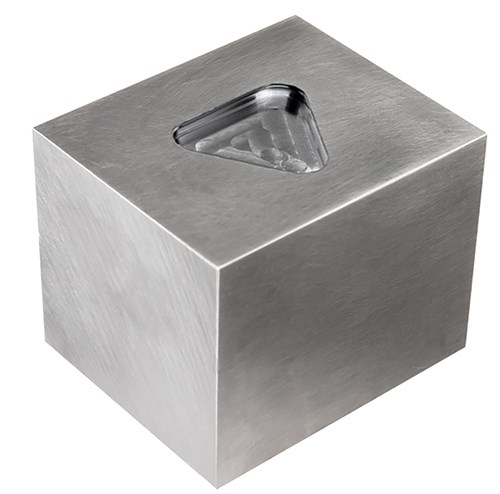Multi-Axis Workholding System Uses Three-Side Dovetail
The Get-A-Grip pedestal fixture for five-axis workholding uses a triangular clamping geometry for the matching workpiece and clamping dovetails.
Share




Several workholding systems for multi-axis machining rely on the clamping force between a shallow dovetail “strip” machined on the clamping side of a workpiece and a matching “slot” on a pedestal fixture. Secure clamping is achieved by tightening the movable side of the slot against the dovetail strip on the workpiece to lock it on the stationary side of the slot.
A new system from AMT Innovations (Orchard Park, New York) is based on a variation of this concept that uses a triangular clamping geometry for the matching workpiece and clamping fixture. The stainless steel pedestal fixture features a shallow clamping pad with three sides bearing a dovetail profile. One side of this pad is stationary. The other part of the pad, which moves to lock and unlock the clamping function, has two adjacent sides with the matching dovetail profile. These sides of the movable portion of the pad form the corner of the triangle opposite the stationary side.
To interface with this triangular clamping pad, the clamping side of the workpiece must have a triangular pocket with an undercut that matches the dovetail profile of the pad. The sides of this triangular pocket are the same length. When the clamping pad is in the unlocked position, the workpiece pocket fits over it so the workpiece rests on the top of the pedestal fixture. Tightening the locking screw draws the movable portion of the locking pad against the two free sides of the workpiece pocket. When full clamping pressure is achieved, the triangular dovetail geometry provides three evenly spaced, radial-force vectors.
Developers claim these even-force vectors do not deform or distort the workpiece while creating more secure gripping than the conventional dovetail clamping systems. This clamping geometry is also said to enable reliable repeatability in part removal and reclamping. The three corners of the clamping pad and the workpiece pocket are rounded with a matching radius. Without the corner radius, each side of the triangle is 1.0 inch long.
The manufacturer is calling this clamping system Get-A Grip. The basic pedestal fixture for the system was introduced at a machine tool distributor’s customer event in late January. This pedestal fixture is available now, while other models will be available later this year. Other components of the modular system are being developed and will be released as they are completed.
This pedestal fixture is similar to other multi-axis workholding systems. It provides bolt holes so that it can be mounted on a machine worktable or upright workholding block. The fixture also lifts the workpiece from the mounting surface so that a cutting tool moving in multiple axes can reach the four sides and top of the workpiece. In a manner of speaking, the pedestal gives the machining head some “elbow room” to tilt and rotate into position without bumping the top of the table or mounting block. Developers say the new system is appropriate for five-axis simultaneous machining as well as 3+2 positioning.
The internal clamping geometry of the workpiece pocket can be located strategically where the finished part may have a larger pocket by design. If this clamping surface butts up against a wall in an assembly work but does not otherwise interfere with the design or function of the part, it can simply be left in place. Otherwise, the surface with the pocket must be removed in the same manner that the dovetail strip required for other systems must be removed.
AMT Innovations offers standard solid carbide form tools that produce the required dovetail and associated material prep features. These tools are available for ferrous and nonferrous materials.
Related Content
How to Mitigate Chatter to Boost Machining Rates
There are usually better solutions to chatter than just reducing the feed rate. Through vibration analysis, the chatter problem can be solved, enabling much higher metal removal rates, better quality and longer tool life.
Read MoreHow to Determine the Currently Active Work Offset Number
Determining the currently active work offset number is practical when the program zero point is changing between workpieces in a production run.
Read MoreLean Approach to Automated Machine Tending Delivers Quicker Paths to Success
Almost any shop can automate at least some of its production, even in low-volume, high-mix applications. The key to getting started is finding the simplest solutions that fit your requirements. It helps to work with an automation partner that understands your needs.
Read MoreWhere Micro-Laser Machining Is the Focus
A company that was once a consulting firm has become a successful micro-laser machine shop producing complex parts and features that most traditional CNC shops cannot machine.
Read MoreRead Next
Building Out a Foundation for Student Machinists
Autodesk and Haas have teamed up to produce an introductory course for students that covers the basics of CAD, CAM and CNC while providing them with a portfolio part.
Read MoreRegistration Now Open for the Precision Machining Technology Show (PMTS) 2025
The precision machining industry’s premier event returns to Cleveland, OH, April 1-3.
Read More5 Rules of Thumb for Buying CNC Machine Tools
Use these tips to carefully plan your machine tool purchases and to avoid regretting your decision later.
Read More


































.jpg;maxWidth=970;quality=90)